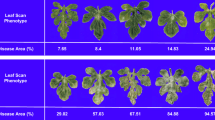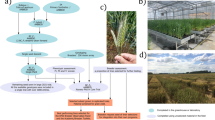Abstract
The objective of this study was to map quantitative trait loci (QTL) for the vernalization response in perennial ryegrass (Lolium perenne L.). The mapping population consisted of 184 F2 genotypes produced from a cross between one genotype of a synthetic perennial ryegrass variety “Veyo” and one genotype from the perennial ryegrass ecotype “Falster”. Veyo and Falster were chosen among four different populations because of their contrasting vernalization requirements. In total, five QTL for the vernalization response, measured as days to heading, were identified and mapped to linkage groups (LG) LG2, LG4, LG6 and LG7. Individually, these QTL explained between 5.4 and 28.0% of the total phenotypic variation. The overall contribution of these five QTL was 80% of the total phenotypic variation. A putative orthologue of Triticum monococcum VRN1 was amplified from genomic DNA from perennial ryegrass. PCR fragments covering the proximal part of the promoter and the 5′ end of the orthologue were subsequently PCR-amplified from both parents of the mapping population and shown to possess 95% DNA sequence identity to VRN1. Several polymorphisms were identified between Veyo and Falster in this fragment of the putative VRN1 orthologue. A CAPS marker, vrn-1, was developed and found to co-segregate with a major QTL on LG4 for the vernalization response. This indicates that the CAPS marker vrn-1 could be located in an orthologous gene of the wheat VRN1.





Similar content being viewed by others
References
Aamlid TS, Heide OM, Boelt B (2000) Primary and secondary induction requirements for flowering of contrasting European varieties of Lolium perenne. Ann Bot (Lond) 86:1087–1095
Alm V, Fang C, Busso CS, Devos KM, Vollan K, Grieg Z, Rognli OA (2003) A linkage map of meadow fescue (Festuca pratensis Huds.) and comparative mapping with other Poaceae species. Theor Appl Genet 108:25–40
Altschul SF, Gish W, Miller W, Myers EW, Lipman DJ (1990) Basic local alignment search tool. J Mol Biol 215:403–410
Armstead IP, Turner LB, Farrell M, Skøt L, Gomez P, Montoya T, Donnison IS, King IP, Humphreys MO (2004) Synteny between a major heading-date QTL in perennial ryegrass (Lolium perenne L.) and the Hd3 heading-date locus in rice. Theor Appl Genet 108:822–828
Benavente E, Orellana J (1989) Pairing competition between identical and homologous chromosomes in autotetraploid rye heterozygous for interstitial C-bands. Chromosoma 98:225–232
Cooper JP (1960) Short-day and low-temperature induction in Lolium. Ann Bot (Lond) 24:232–246
Danyluk J, Kane NA, Breton G, Limin AE, Fowler DB, Sarhan F (2003) TaVRT-1, a putative transcription factor associated with vegetative to reproductive transition in cereals. Plant Physiol 132:1849–1860
Dubcovsky J, Lijavetzky D, Appendino L, Tranquilli G (1998) Comparative RFLP mapping of Triticum monococcum genes controlling vernalization requirements. Theor Appl Genet 97:968–975
Fang C, Aamlid TS, Jørgensen Ø, Rognli OA (2004) Phenotypic and genotypic variation in seed production traits within a full-sib family of meadow fescue. Plant Breed 123:241–246
Forster JW, Jones ES, Batley J, Smith KF (2004) Molecular marker-based genetic analysis of pasture and turf grasses. In: Hopkins A, Wang ZY, Mean R, Sledge M, Barker RE (eds) Molecular breeding of forage and turf. Kluwer, Dordrecht, pp197–238
Frisch M, Quint M, Lübberstedt T, Melchinger AE (2004) Duplicate marker loci can result in incorrect locus orders on linkage maps. Theor Appl Genet 109:305–316
Fu H, Dooner HK (2002) Intraspecific violation of genetic colinearity and its implications in maize. Proc Natl Acad Sci USA 99:9573–9578
Gocal GF, King RW, Blundell CA, Schwartz OM, Andersen CH, Weigel D (2001) Evolution of floral meristem identity genes. Analysis of Lolium temulentum genes related to APETALA1 and LEAFY of Arabidopsis. Plant Physiol 125:1788–1801
Guidet FLY, Rogowsky P, Taylor C, Langridge P (1991) Cloning and characterization of a new rye specific repeated sequence. Genome 34:81–87
Hayward MD, Mcadam NJ, Jones JG, Evans C, Evans GM, Forster JW (1994) Genetic markers and the selection of quantitative traits in forage grasses. Euphytica 77:269–275
Heide OM (1994) Control of flowering and reproduction in temperate grasses. New Phytol 128:347–362
Holland JB, Moser HS, O’Donoughue LS, Lee M (1997) QTLs and epistasis associated with vernalization responses in oat. Crop Sci 37:1306–1316
Holmes W (1980) Grass: its production and utilization. Blackwell, Oxford
Jensen CS, Salchert K, Nielsen KK (2001) A TERMINAL FLOWER1-like gene from perennial ryegrass involved in floral transition and axillary meristem identity. Plant Physiol 125:1517–1528
Jensen CS, Salchert K, Gao C, Andersen CH, Didion T, Nielsen KK (2004) Floral inhibition in red fescue (Festuca rubra L.) through expression of a heterologous flowering repressor from Lolium. Mol Breed 13:37–48
Jeon JS, Lee S, Jung KH, Yang WS, Yi GH, Oh BG, An G (2000) Production of transgenic rice plants showing reduced heading date and plant height by ectopic expression of rice MADS-box genes. Mol Breed 6:581–592
Jones ES, Dupal MP, Iliker RK, Drayton MC, Forster JW (2001) Development and characterization of simple sequence repeat (SSR) markers for perennial ryegrass (Lolium perenne L.). Theor Appl Genet 102:405–415
Jones ES, Dupal MP, Dumsday JL, Hughes LJ, Forster JW (2002a) An SSR-based genetic linkage map for perennial ryegrass (Lolium perenne L.). Theor Appl Genet 105:577–584
Jones ES, Mahoney NL, Hayvard MD, Armstead IP, Jones JG, Humphreys MO, King IP, Kishida T, Yamada T, Balfourier F, Charmet G, Forster JW (2002b) An enhanced molecular marker based genetic map of perennial ryegrass (Lolium perenne) reveals comparative relationships with other Poaceae genomes. Genome 45:282–295
Knott SA, Neale DB, Sewell MM, Haley CS (1997) Multiple marker mapping of quantitative trait loci in an outbred pedigree of loblolly pine. Theor Appl Genet 98:586–592
Kubik C, Meyer WA, Gaut BS (1999) Assessing the abundance and polymorphism of simple sequence repeats in perennial ryegrass. Crop Sci 39:1136–1141
Kubik C, Sawkins M, Meyer WA, Gaut BS (2001) Genetic diversity in seven perennial ryegrass (Lolium perenne L.) cultivars based on SSR markers. Crop Sci 41:1565–1572
Laurie DA (1997) Comparative genetics of flowering time. Plant Mol Biol 35:167–177
Laurie DA, Pratchett N, Bezant JH, Snape JW (1995) RFLP mapping of five major genes and eight quantitative trait loci controlling flowering time in a winter × spring barley (Hordeum vulgare L.) cross. Genome 38:575–585
Mei HW, Luo LJ, Ying CS, Wang YP, Yu XQ, Guo LB, Paterson AH, Li ZK (2003) Gene actions of QTLs affecting several agronomic traits resolved in a recombinant inbred rice population and two testcross populations. Theor Appl Genet 107:89–101
Murai K, Takumi S, Koga H, Ogihara Y (2002) Pistillody, homeotic transformation of stamens into pistil-like structures, caused by nuclear-cytoplasm interaction in wheat. Plant J 29:169–181
Plaschke J, Börner A, Xie DX, Koebner RMD, Schlegel R, Gale MD (1993) RFLP mapping of genes affecting plant height and growth habit in rye. Theor Appl Genet 85:1049–1054
Pugsley AT (1971) A genetic analysis of the spring–winter habit in wheat. Aust J Agric Res 22:21–31
Sawbridge T, Ong E, Binnion C, Emmerling M, McInnes R, Meath K, Nguyen N, Nunan K, O’Neill M, O’Toole F, Rhodes C, Simmonds J, Tian P, Wearne K, Webster T, Winkworth A, Spangenberg G (2003) Generation and analysis of expressed sequence tags in perennial ryegrass (Lolium perenne L.). Plant Sci 165:1089–1100
Schmitz J, Franzen R, Ngyuen TH, Garcia-Maroto F, Pozzi C, Salamini F, Rohde W (2000) Cloning, mapping and expression analysis of barley MADS-box genes. Plant Mol Biol 42:899–913
See E, Kanazin V, Kephart K, Blake T (2002) Mapping genes controlling variation in barley grain protein concentration. Crop Sci 42:680–685
Snape JW, Law CN, Worland AJ (1976) Chromosome variation for loci controlling ear-emergence time on chromosome 5A of wheat. Heredity 37:335–340
Snape JW, Butterworth K, Whitechurch E, Worland AJ (2001) Waiting for fine times: genetics of flowering time in wheat. Euphytica 119:185–190
Sybenga J (1999) What makes homologous chromosomes find each other in meiosis? A review and an hypothesis. Chromosoma 108:209–219
Takahashi R, Yasuda S (1971) Genetics of earliness and growth habit in barley. In: Nilan RA (ed) Proceedings of the second international barley genetics symposium. Washington State University Press, pp 388–408
Thorogood D, Kaiser WJ, Jones JG, Armstead I (2002) Self-incompatibility in ryegrass 12. Genotyping and mapping the S and Z loci of Lolium perenne L. Heredity 88:385–390
Tranquilli G, Dubcovsky J (2000) Epistatic interaction between vernalization genes Vrn-A m 1 and Vrn-A m 2 in diploid wheat. J Hered 91:304–306
Trevaskis B, Bagnall DJ, Ellis MH, Peacock WJ, Dennis ES (2003) MADS box genes control vernalization-induced flowering in cereals. Proc Natl Acad Sci USA 100:13099–13104
Utz HF, Melchinger AE (1994) Comparison of different approaches to interval mapping of quantitative trait loci. In: van Ooijen JW, Jansen J (eds) Proceedings of the ninth meeting of the EUCARPIA section “Biometrics in plant breeding”. Biometrics in plant breeding: applications of molecular markers, Wageningen, 6–8 July 1994, pp195–204
Van Deynze AE, Nelson JC, O’Donoughue LS, Ahn SN, Siripoonwiwat W, Harrington SN, Yglesias ES, Braga D, McCouch SR, Sorrels ME (1995) Comparative mapping in grasses. Oat relationships. Mol Gen Genet 249:349–356
Van Ooijen JW, Voorrips RE (2001) Joinmap 3.0, Software for the calculation of genetic linkage maps. Plant Research International, Wageningen, The Netherlands
Van Ooijen JW, Boer MP, Jansen RC, Maliepaard C (2002) MapQTL 4.0, Software for the calculation of QTL positions on genetic maps. Plant Research International, Wageningen
Yan L, Loukoianov A, Tranquilli G, Helguera M, Fahima T, Dubcovsky J (2003) Positional cloning of the wheat vernalization gene VRN1. Proc Natl Acad Sci USA 100:6263–6268
Acknowledgements
The authors thank The Danish Directorate for Food, Fisheries and Agribusiness for financial support. We would like to thank Dr. Birte Boelt from DIAS for her advice regarding the development and phenotyping of the mapping population. Ann Johansen and Sanne Seval are thanked for excellent technical assistance, and Ole Braad Hansen for taking optimal care of the plants.
Author information
Authors and Affiliations
Additional information
Communicated by C. Möllers
Rights and permissions
About this article
Cite this article
Jensen, L.B., Andersen, J.R., Frei, U. et al. QTL mapping of vernalization response in perennial ryegrass (Lolium perenne L.) reveals co-location with an orthologue of wheat VRN1 . Theor Appl Genet 110, 527–536 (2005). https://doi.org/10.1007/s00122-004-1865-8
Received:
Accepted:
Published:
Issue Date:
DOI: https://doi.org/10.1007/s00122-004-1865-8




